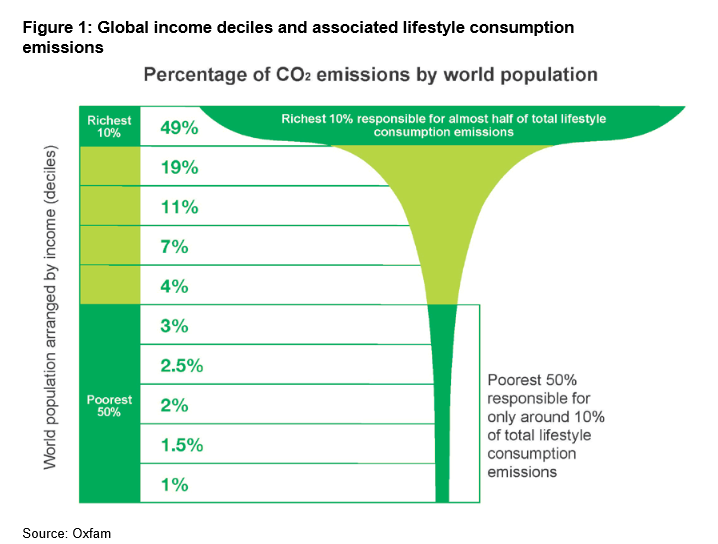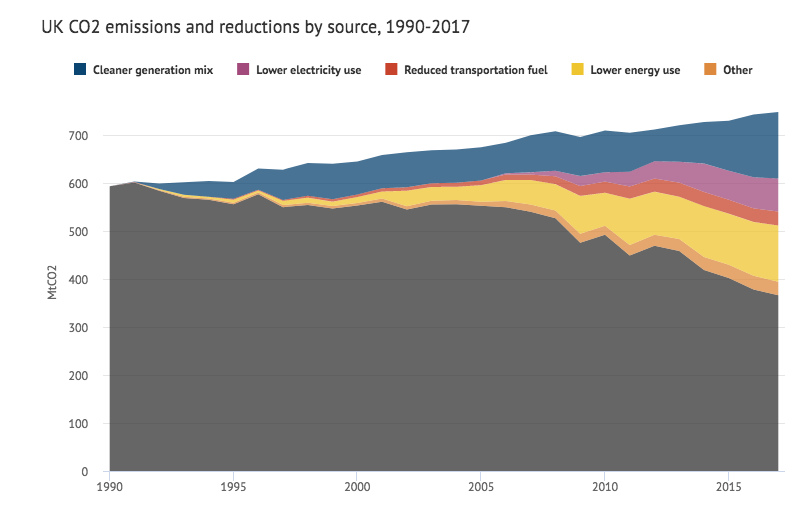What are GHG (Greenhouse Gas) Emissions? A Definition
Greenhouse gas or GHG emissions are defined as gas-based air pollution that contribute to climate change and global warming. The most common GHG emission is carbon dioxide, abbreviated CO2. There are also other GHGs like methane (CH4) and nitrous oxide (N2O)
Greenhouse gas emissions trap heat in the atmosphere, which makes the Earth warmer and is the top contributor to global climate change. GHG is primarily released by burning fossil fuels like coal, oil, and natural gas for energy or transportation. GHG can also be released by wildfires, deforestation, industrial agriculture, livestock, refrigeration, manufacturing, and other sources.

Global GHG emissions are about 50 gigatons per year, equal to roughly 6.6 tons per person, according to Oxford University's Our World in Data project.
The Modern History of Greenhouse Gas (GHG) Emissions
Throughout human history, the Earth's GHG emissions have remained relatively stable. After the industrial revolution - and particularly in the last 40 years - human agriculture, fossil fuel-based energy, industry, and transportation have caused global GHG pollution levels to spike dramatically. Our planet is now warming to dangerously unsustainable levels, and temperatures (and consequences) will keep rising until we reach "net zero" emissions and balance global emissions and carbon capture.
Global Atmospheric Concentrations of Carbon Dioxide GHG Emissions Since the Industrial Revolution
Last Updated: 2022
Source: EPA Climate Change Indicators, last certified in 2022.
On a long-term timeline, that emissions growth may not look that bad. But it starts to get very alarming when you zoom in on just on the last 50 years of GHG emissions produced by fossil fuels.
What's causing all this emissions growth?
GHG Emissions by Economic Source
Climate change and GHG emissions are principally caused, in order of amount, by burning fossil fuels to create electricity and heat, factory farming (primarily animals and livestock), industrial manufacturing, and using non-electric cars, planes, and cargo ships. There are other sources of GHG, but those are the main culprits.
Where GHG Emissions Comes From (Greenhouse Gas Emissions Source Breakdown)
Last Updated: May 4, 2019
Source: UN IPCC and Brightest.
If we’re going to solve our current climate crisis, we need to get to net zero or near-zero emissions across agriculture, electricity, manufacturing, and transportation as quickly as possible. In other words, we need to radically decarbonize our economy across every big slice in that pie. And we need to do it in ways that still work for society (like making sure people have good-paying jobs, enough food to eat, and vulnerable, front-line communities don't get overlooked).
GHG Emissions by Country
As the two largest global economies, China and the United States are the two countries that emit the most GHG per year. However, while the United States has reduced its rate of annual GHG emissions, China still has not done so.
Together, China, India, and other Asia-Pacific economies are creating half of all the new GHG being released into the world, which makes solving climate change at the very least a geopolitical America-plus-China team effort.
In fact generally, there's a big, global inequality distribution around climate change and GHG. The poorest half of the world's population - those who are being first and hardest by the climate crisis - only contribute 10% of global GHG emissions. They're not the problem. And they're not the ones who need to change.

GHG Emissions by Company
There is also a significant corporate accountability lens on global GHG emissions. In fact, research indicates just 100 fossil fuel corporations, including ExxonMobil, Shell, BHP Billiton, and Gazprom, are responsible for 52% of all GHG emissions worldwide since the industrial revolution. They're also responsible for the majority of climate denial propaganda and money to fund politicians who won't regulate their environmental damage.
The Solution to GHG Emissions is Decarbonization
Decarbonization means reduction of carbon, specifically, carbon dioxide (CO2), and other GHGs.
When it comes to decarbonization, there are essentially three ways to do it.
- Replace - Substitute a lower emissions method for a higher emissions method. For example, replace electricity generated by a coal power plant with solar energy, wind, hydroelectric, or nuclear
- Reduce - Simply reduce or use less or a resource, like energy
- Capture - Carbon capture or sequestration takes carbon out of the atmosphere and stores it safely. For example, 50% of the organic mass of a tree is stored carbon, and forests are one of Earth's most powerful natural carbon capture mechanisms

Common steps companies and countries take to decarbonize their GHG emissions include:
- Reducing energy consumption and usage through energy efficiency and smart grid improvements
- Using clean energy (solar, wind, water, nuclear) instead of fossil fuels (oil, gas, coal)
- Replacing fossil fuel transportation with electric vehicles
- Reducing industrial agriculture and introducing more sustainable farming and land practices
- Replacing inputs and raw materials with more sustainable alternatives
- Value chain efficiency optimization and supply chain sustainability improvements
- Improved circularity, re-use, recycling, and end-of-life treatment for finished and discarded goods and products
- Carbon capture, tree planting, kelp farming, and other methods to remove and sequester atmospheric CO2
Today, most companies and governments who are thoughtfully pursuing decarbonization use most if not all of these tactics to reduce their GHG and carbon emissions.
GHG Emissions Decarbonization Example - United Kingdom
One encouraging example of economic GHG decarbonization is the United Kingdom. The British economy's CO2 emissions peaked in 1973 and declined significantly between 2003 and 2020, faster than any other major country.
How did the UK achieve such impressive GHG emissions reduction results? Primarily by using less energy, and more clean energy.

Transitioning from coal-fueled electricity production to (cleaner) natural gas and renewable energy accounted for 36% of the UK's GHG reduction success. Reducing industrial and household energy usage contributed another 31%. Together, these two transition steps contributed more than two thirds of British decarbonization over one and a half decades. During this same period - outside the 2008-2009 financial crisis and 2020+ COVID-19 pandemic - the UK achieved steady 2-3% annual GDP growth.
These same GHG emissions reduction steps - greater energy efficiency, lower energy consumption, and increased use of renewable energy - can be achieved by companies as well, not just governments, with similar outcomes.
Worldwide, 32 countries have begun decoupling their GHG emissions growth from GDP growth, including the U.S. and Germany. But as scientists, researchers, and sustainability advocates note, the decoupling isn't happening fast enough. The global economy isn't decarbonizing as a whole. Atmospheric carbon and GHG emissions remain at historic, record highs. The ongoing challenge is how do we decarbonize and reduce or capture more GHG emissions, faster.
Taking Action on Your GHG Emissions
While certain companies, countries, and policymakers deserve particular accountability for the current state of GHG emissions growth and climate change, we all have a collective responsibility to do the best we can in our own lives to reduce our GHG emissions.
One of the best ways you can have a positive impact is to vote, protest, and participate in your country's political process to the extent you're able. Reducing GHG emissions requires strong environmental laws at the national and local level, particularly when it comes to energy utilities using fossil fuels. After that, look at what organizations you can influence. Can you make company-sized change where you work? And finally, look at the largest sources of emissions in your own life (air travel, driving gas or diesel cars, eating meat) and consider if there are improvements you'd like to make.
Climate action and GHG emissions reduction may feel time-consuming, complicated, expensive, or another thing to worry about. But the reality is each and every one of us can make a positive different by advocating and educating each other, and making better decisions when it comes to GHG emissions. A central part of our mission at Brightest is helping companies and governments measure, reduce, and report their carbon and GHG emissions.
If we can be helpful in your organization's emissions reduction journey, please be in touch.





